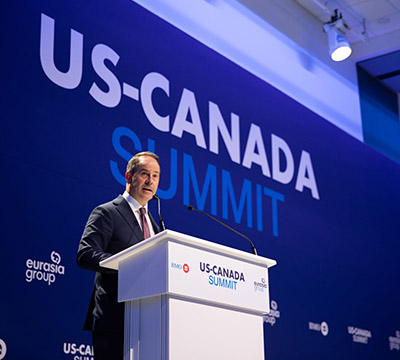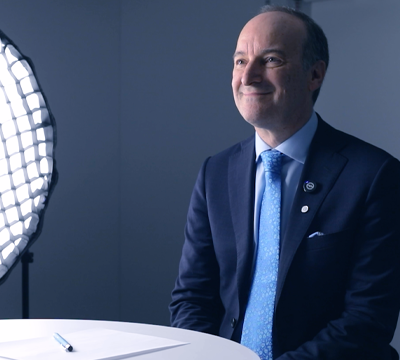How can investors navigate market uncertainty? Hear from a BMO expert
This year has brought much economic uncertainty so far, and many investors are wondering how their portfolios may be affected – should they “buy the dip” and take advantage of potential stock declines, or should they stay the course? Sadiq Adatia, Chief Investment Officer at BMO Global Asset Management, recently sat down with the Globe and Mail to share his insights on what to expect during periods of high market volatility*, and how investors can best weather the storm to continue making real financial progress. You can read the full interview here, and we’ve included a condensed version below:
What is your outlook on the tariff timeline and trajectory?
“Our expectation is not that it will be zero, and our expectation is not that it’s going to be 25 per cent, so somewhere in between is where we’re expecting it to play out,” says Sadiq. “But to be honest with you, it’s really hard to predict when you don’t know what the end game is, and the targets keep moving as well.”
Sadiq notes that because of uncertainty, GDP is expected to slow down. “The outlooks by corporations are going to be a bit more muted because they don’t know what they’re going to be investing in, what the input costs are going to look like and how consumers are going to react until they have some certainty on the tariff situation,” he says.
How could investors navigate heightened market volatility?
Market declines are nothing new – and since there haven’t been too many over the last few years, Sadiq notes that we were probably due for one. Given the recent turbulence, it’s understandable that investors are feeling cautious.
Despite this, Sadiq mentions that companies with robust future earning potential that have a “strong moat” and brand awareness will be priced at a discount – and for those with a longer investing horizon, that brings opportunity. “With an investment horizon that’s longer than three months, investors could potentially be buying on some of those dips – but I think there’s still a little bit more pullback that’s required to get to a comfortable level of buying on the dip,” he added.
When could be a good time to buy in?
Since each sector is different, it’s hard to say how much of a pullback is necessary. With recent declines, Sadiq recommends investors wait until there is a 20 per cent decline on the NASDAQ and around a 15 percent decline on the S&P500 to start dipping their toes back in.
“When the market is down 15 per cent, that means some stocks are down 20, 25 per cent. I think investors should aim for the quality ones, especially during uncertainty. Look for companies that have good balance sheets with solid brand awareness that can potentially pass higher input costs to the end consumer without impacting their margins significantly,” he noted.
What should investors be paying close attention to?
Sadiq reiterates that investors should continue to monitor geopolitical risk – which he believes has not been fully priced into the market – and encourages investors to keep tariff and trade uncertainties top of mind.
Even with the turbulence we’ve seen so far, market volatility is a part of investing – and Sadiq reminds investors that good returns on the stock market naturally come with some risk.
“As an investor, you’ll have to ride the bumps along the way, and we’re definitely seeing bigger bumps at the moment. Buying the dip could be ideal, but investors should know that they may not get rewarded with higher returns on the short term.”
– Sadiq Adatia,
Chief Investment Officer at BMO Global Asset Management
Sadiq’s perspective: use the power of patience
Sadiq concludes that in times of market volatility, investors should remain patient. “We’ve had hiccups in the market of more than 10 per cent many times – and we get through them. Investors may even kick themselves for not buying on some of those dips,” he added.
Despite this, those with a shorter-term investing horizon may still be nervous about potential downsides. In this case, Sadiq recommends reducing allocations to risk.
Read more thought leadership from BMO experts
Disclaimer
Any statement that necessarily depends on future events may be a forward-looking statement. Forward-looking statements are not guarantees of performance. They involve risks, uncertainties and assumptions. Although such statements are based on assumptions that are believed to be reasonable, there can be no assurance that actual results will not differ materially from expectations. Investors are cautioned not to rely unduly on any forward-looking statements. In connection with any forward-looking statements, investors should carefully consider the areas of risk described in the most recent simplified prospectus.
The viewpoints expressed by the speaker represents their assessment of the markets at the time of publication. Those views are subject to change without notice at any time. The information provided herein does not constitute a solicitation of an offer to buy, or an offer to sell securities nor should the information be relied upon as investment advice. Past performance is no guarantee of future results. This communication is intended for informational purposes only.
This communication is for information purposes only. The information contained herein is not, and should not be construed as investment, tax or legal advice to any party. Particular investments and/or trading strategies should be evaluated and professional advice should be obtained with respect to any circumstance.
BMO Global Asset Management is a brand name under which BMO Asset Management Inc. and BMO Investments Inc. operate.
“BMO (M-bar roundel symbol)” is a registered trademark of Bank of Montreal, used under licence.
*Volatility: Measures how much the price of a security, derivative, or index fluctuates. The most commonly used measure of volatility when it comes to investment funds is standard deviation.
Standard Deviation: A measure of risk in terms of the volatility of returns. It represents the historical level of volatility in returns over set periods. A lower standard deviation means the returns have historically been less volatile and vice-versa. Historical volatility may not be indicative of future volatility.








